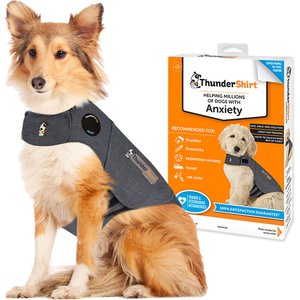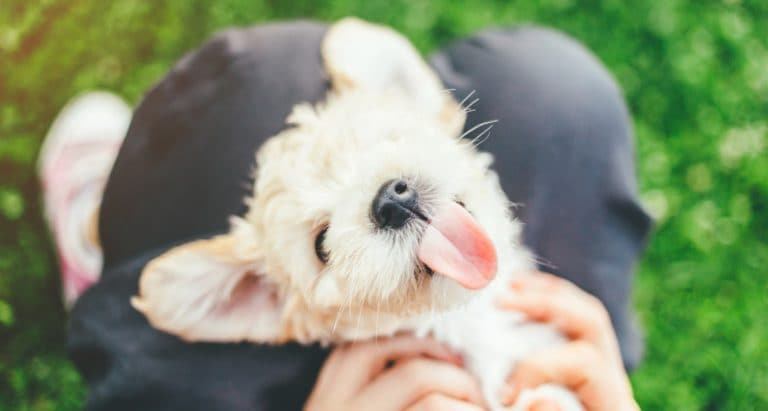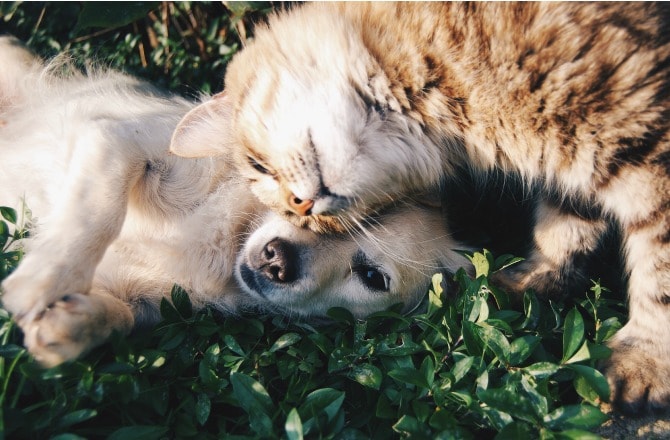We’ve all seen those adorable puppy dog eyes that our pooches give us—they’re so easy to get lost in. But have you ever wondered why dogs give us those cute puppy eyes?
If you want to learn more about the science behind dog expressions and how to interpret them, read on to find out what’s behind those puppy eyes and how dog body language really works.
Why Is Your Pooch Giving You Puppy Dog Eyes?
Russell Hartstein, certified dog/cat behaviorist, trainer and CEO (Canine Executive Officer) of Fun Paw Care in Los Angeles, explains that “Dogs are highly attuned animals that share our emotional states. Many times, dogs are simply reflecting back our mood, emotion and state of being, which are oftentimes undetected by people.”
Pet parents often mistake their dog’s expressions to be a reaction to the food or treats in their hand, but scientific findings have shown that dogs are more sensitive to a human’s attention than to the object in their hands. Although puppy dog eyes might seem cute to us, sometimes they’re actually a sign that your dog is stressed.
Cute vs. Sad Puppy Dog Eyes—How to Spot the Difference
No pet parent wants their furry friend to feel sad, which is why it’s important to know the difference between when your pooch gives you cute puppy eyes versus sad puppy eyes. Hartstein explains that pet parents “can detect subtle and overt emotional conditions in their pet’s face, such as a tense vs. relaxed mouth, eye openings, eye positioning and dilation, tongue position, and brow and ear positioning.”
Paying attention to all of these factors will reveal a great deal of information about your pooch’s emotional state. You can also determine if your pup has “soft” or “hard” eyes.
Soft Eyes
Hartstein points out that if your pooch’s eyes are soft, this is the sign of a social dog, with a friendly demeanor, who is affable and confident. A pooch with soft eyes will typically have relaxed eyes and might blink often. This is what most pet parents refer to as the puppy dog eyes that are so easy to get lost in!
Hard Eyes
“This type of eye contact is not healthy or positive,” warns Hartstein.
It signifies stress, aggression, fear and unfriendly behavior. If your pooch exhibits this facial expression, it does not always mean he is a bad pooch—more than likely, there are outside factors that are causing him stress and putting him on the defensive. If your pup could use some extra comforting, try the Adaptil Electric Dog Diffuser that naturally bathes your home in the canine-appeasing pheromone to calm both puppies and adult dogs.
Avoidance of Eye Contact
Avoiding eye contact is completely normal in well-socialized dogs, notes Hartstein.
“While many pet parents will condition and reward their pooch to lock eyes in a loving way with them, your pooch is likely to avoid direct eye contact with strangers or any unfamiliar being, as this can be perceived as confrontational, a threat, instigation and unfriendly,” he says.
Don’t be surprised if your fur baby shies away from unfamiliar contact! If your pup has a tendency to get stressed in social situations, try the ThunderShirt Anxiety & Calming Solution for Dogs to keep him relaxed in unfamiliar situations.
What Do Different Dog Expressions Mean?
Similar to humans, dogs feel a wide range of emotions and express their feelings through body language and nonverbal communication. According to Hartstein, a large part of this nonverbal communication takes place in dog expressions, which is why some pet parents and “observant people schooled in animal behavior can tell when a dog is stressed, tired, apprehensive, confident, unsure, betrayed, confused, loving, happy, elated or sad” based on the faces they are making.
Hartstein highlights the importance of paying attention to your dog’s entire body when trying to determine the emotional state your dog is in—not just focusing on the facial expression alone. According to Hartstein, even though “each part of the dog’s head can be analyzed independently, the whole story about your pup’s emotional state is not told without observing the entire body and environment.”
Hartstein also emphasizes the importance of context when trying to decipher a pet’s state of emotion.
“Humans often misidentify the meaning of a dog’s expression—for example, just because a dog is wagging its tail, it does not mean the dog is friendly in the moment and ok to approach,” he says.
Pet parents should “always look at the entire dog and environment instead of just looking at a dog’s facial expression.”
If your dog needs help feeling more comfortable in social situations, Hartstein suggests “letting your dog slowly and cautiously approach others on his own instead of forcing an interaction onto him.”

Having recently moved from rainy Oregon to the sunshine state, Anastasiya Chevtchenko spends her time catching rays by the beach, playing soccer with the locals, and embracing pet heaven – Chewy. A recent Penn graduate, Anastasiya works in Marketing where she hopes to bring in her expertise in international relations to expand the business. When she’s not facetiming her international friends or reading the news in five languages, Anastasiya spends her time working on PR projects, social media brand posts, and writing for Chewy’s BeChewy blog.
Share:












